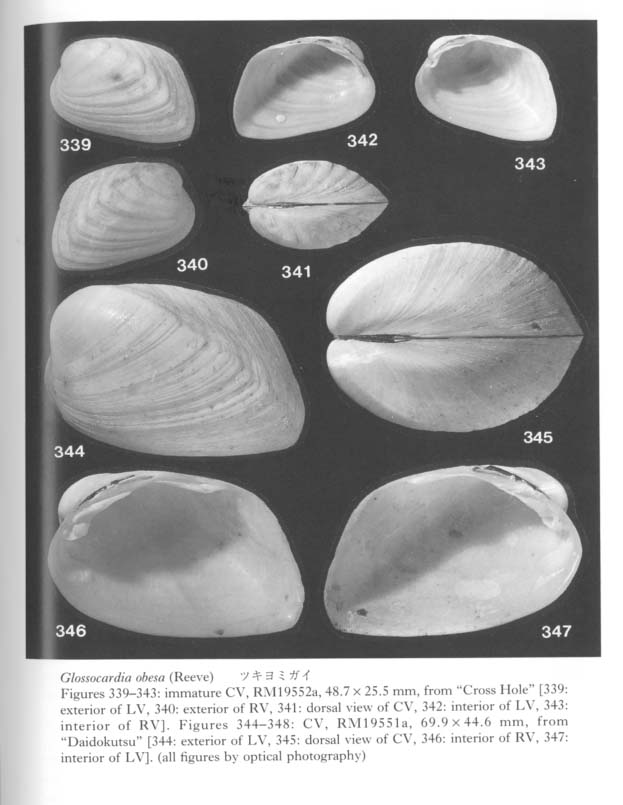Glossocardia obesa (Reeve, 1843)
Figures 339-347

1843. Cypricardia obesa Reeve, Conchologia Iconica, vol.2, pl.2, fig.10.
1870. Glossocardia obesa: Stoliczka, Palaeont. Indica, ser.6, vol.3, p.189.
1875. Cypricardia obesa: Woodward, A Manual of the Mollusca, p.467, pl.20, fig.4.
1951. Glossocardia obesa: Habe, Genera of Japanese Shells, Pelecypoda, no.1, p.118, figs.247, 248.
1969. Trapezium (Glossocardia) obesum: Keen in Cox et al., Treatise on Invertebrate Paleon- tology, Part N, vol.2, p.N655, fig.E132-la,b.
1977. Glossocardia obesa: Habe, Systematics of Mollusca in Japan, Bivalvia and Scaphopoda, p.234, pl.50, figs.1, 2.
Material.— The material related to the present study consists of a few specimens of various growth stages. One is a large articulated specimen (RM19551a) found near the entrance of "Daidokutsu" of Ie Islet, Okinawa, and other specimens are living and dead juveniles (RM19552) from the sediments of "Cross Hole" of Irabu Islet, Miyako Islands.
Descriptive remarks.— Glossocardia obesa was originally described from India by Reeve (1843) and subsequently recorded from Mauritius (Stoliczka, 1871). It has been said to occur also in the tropical West-Pacific region, but its distribution and habitat have not been clarified. Little has been known about its ontogenetic and anatomical features. G. obesa may also be an uncommon species in southern Japan, but cooperative divers found fresh empty shells (and, rarely, living individuals) in and around submarine caves open to fore-reef slopes in the Ryukyu Islands.
The specimens from the Ryukyus are similar to the Indian specimens (Reeve, 1843; Woodward, 1875; Fischer, 1880-87) in hinge and other essential characters. The. outline of the shell is, however, slightly different; the adult articulated specimen (exceeding 65mm in length and 50mm in thickness) from Ryukyu looks more strongly ventricose, more transversely elongated with almost linearly truncated (not sinuate) posterior margin, as illustrated by Habe (1951, 1977a) and herein (Figures 334-338). The difference is attributable to geographic variation within a species, even though subspecific distinction may be possible for the west Pacific populations.
The arcticoid dentition of G. obesa can be formulated as: 3a 1 3b PI PII/2a 2b 4b PII. The anterior lateral teeth are undeveloped; 3 a very diminutive and rudimentary, 1 large and tubercular (though lamellar and much weaker in juvenile stage), 3b elongated and bifid, 2a and 2b continuous, forming an arch, and posterior lateral teeth completely developed.
The juvenile specimens from "Cross Hole" reveal less ventricose and shorter valves and more centrally located umbo in comparison with the adult specimens. The prodissoconch features are unknown.
Prashad (1932) described another species, Glossocardia stoliczkana, from a Siboga station in the Sulu Sea (564 m in depth). The hinge structure resembles that of G. obesa (especially its juvenile specimens), but the holotype of the bathyal species differs from the present juvenile specimens of similar size in the more obtusely angulated postero-dorsal corner and more distinct median carina.
The shell of G. obesa is almost free from sculpture and appears to be defenseless against predators, unlike many clams in and around coral reefs. These lines of evidence suggest that G. obesa represents a relict species inhabiting cryptic environments, even though the fossil record of this genus is scarcely known.
Superfamily Veneroidea Rafinesque, 1815
Family Veneridae Rafinesque, 1815
Subfamily Tapetinae Adams and Adams, 1857
Genus Irus Schmidt, 1818
The species of. Irus are commonly rock-nestling organisms (Morton, 1983; others). They are microcryptic, utilizing small rock (or coral reef) cavities which were bored by other organisms. Two minute species of Irus, unlike several described species of this genus, were found alive on the sediment surface in these caves; one is characterized by numerous radial threads between raised commarginal lamellae, and the other is not. These are preliminarily described as stunted cavernicolous species, but it is still uncertain whether the present materials contain adult specimens or merely represent young crawling stages of rock-nestling species.